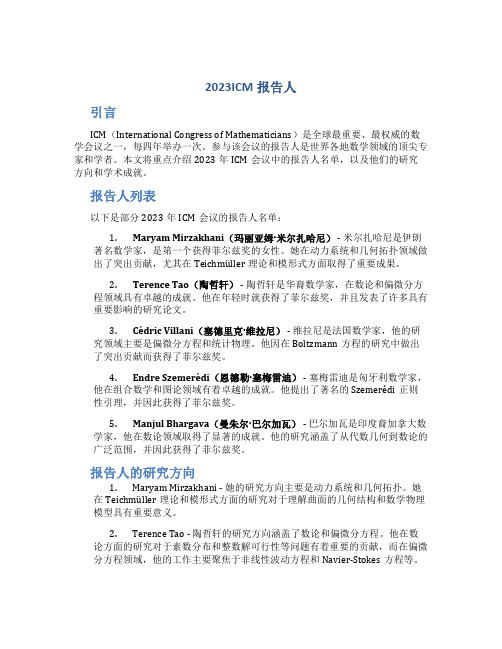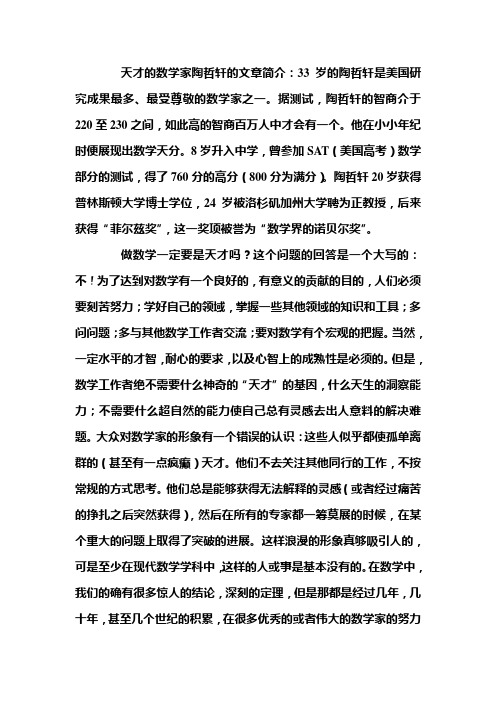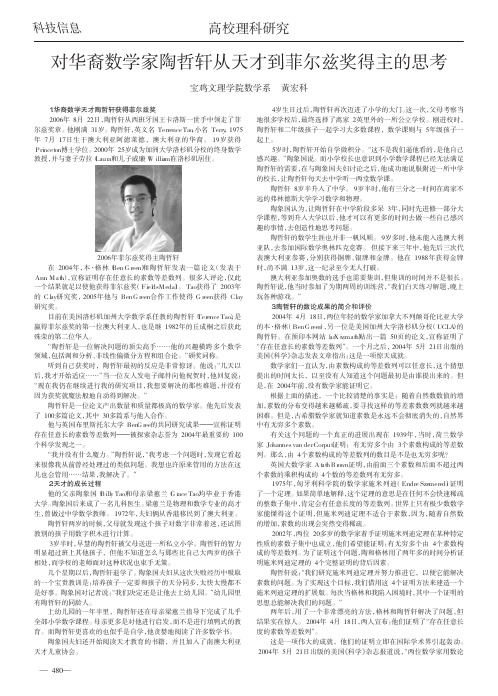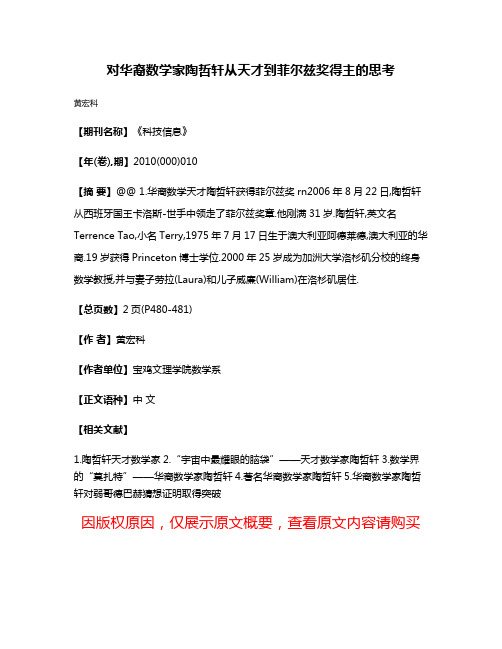陶哲轩获菲尔兹奖论文
把热爱当事业的“数学天才”

把热爱当事业的“数学天才”作者:朱迎兵来源:《新一代·上半月》2010年第03期2006年5月22日,第25届国际数学家大会在马德里举行,开幕式上颁发的菲尔兹奖引人瞩目,此奖四年一次,被誉为“数学界的诺贝尔奖”,颁发给40岁以下的数学家。
当西班牙国王将金灿灿的奖章颁发给一个年轻人时,全场掌声雷动。
那年轻人黑头发黄皮肤,外表随和俊朗。
他就是31岁的澳籍华裔数学家陶哲轩。
他也是该奖70年来最年轻的得主。
陶哲轩被人誉为“数学天才”,他研究成果丰硕,如今是微分方程、调和分析、解析数论等领域的大师级年轻高手。
他知名的研究还包括质数,他证明了即使在无穷大的质数数列中,也能找到等差数列段。
这项研究是他获得菲尔兹奖的主要原因。
陶哲轩获得如此大的成就,很容易让人想到他是一位苦坐书斋的数学家。
可是事实并非如此。
他还像一个孩子,喜欢打电子游戏,一打就是几个小时。
他博客上有一篇题为《量子力学与古墓丽影》的论文,其中一系列妙趣横生的类比,是他从打游戏中获得的灵感。
陶哲轩喜欢摄影,他目前居住在阳光灿烂的南加利福尼亚,常在周末和家人郊游,用数码相机给家人留影。
一次,他的相机淋了雨,很多相片由于没有来得及放置到电脑中,看不清了。
他动用了数学家的思维,思考能否在丢失了大部分的数据后,去重建原始图像。
为此他投入了大量的精力研究。
并完成了几篇论文。
这就是压缩感知研究。
由于陶哲轩的介入,压缩感知已经成为应用数学里最热门的研究之一,吸引了人们极大的关注。
陶哲轩最想做的事情不是待在研究室里,而是将数学在普通人中推广,他的计划中有一项是教那些非数学家如何数学性地思考,“这对日常生活大有用处,譬如算一算怎样抵押贷款更划算,我相信可以教会所有人。
”他还说有很多人以为数学是穷人、卑微者主攻的学科,其实它同样能制造百万富翁和亿万富翁。
“在美国,许多数学家通过运用数学赚到了大钱并赢得人们的尊重,Google的创始人就是数学博士,他设计了一套教学运算法则来搜索网页,然后成了亿万富翁。
科学才子陶哲轩

谈到自己, 陶哲轩表示, 虽然父母是 中国 人, 但自己主要还是个澳大利亚人. 不过, 他风 趣地补充说 : “ 这可不意味着我在 ( 澳大利亚) 内
的 奖项后说, 荣获此奖 对他是 个“ 意外惊喜气而
能有机会与众多国际数学界前辈相提并论, 更 是有些“ 诚惶诚恐” . 圈内知情人士说, 他太谦虚 了 ! 仅凭他在 2004 年与人合作发表的一篇证 明存在任意长 的素 等差 列 的论文, 就足 以 使他获得菲尔茨奖. 从 n 岁起, 陶哲轩开始参 加国际奥林匹克 学竞赛, 13 岁时获得金牌, 成
的出色的老 师 和导 师 . 他表 示 : “ 希望 其 他数 学
性” 等各个条目下, 人们可以看到这个数学奇才 收录的名人名言. 获奖后, 当被人们问道, 为什
家能在我的研究成果基础上取得更进一步的成
另一得主— 俄罗斯数学家格里戈里 佩雷尔 曼. 他在网页上写道 : “ 就我个人的观点, 格里戈
外, 陶 哲 轩 还不 忘把 赞 香留 给 今年 菲 尔 茨奖的
里 佩雷尔曼的主作才是过去 10 年里最重大
的数学成就, 他证明了庞加莱猜想, 和他同时获 奖, 我真是惭 愧 . ” 陶哲 轩所研究 的理论领域是 调和分析、 偏微分方程、 组合数学、 解析数论、 代 数几何等. 他的最新突破是与剑桥大学的本 格林共同取得的, 证明了存在任意长的素数等 差数列. 这曾经让数学家困惑了几百年. 尽管在 儿童时期花了大部分时间自学, 陶哲轩总是肯 定别人对 自己的帮助. 他说 : “ 我发现, 如果我把 自己学到的东西教给两个弟弟, 我总是学得更 好. ” 刚刚 11 岁, 陶哲轩就开始教弟弟们下棋和 演奏乐器. 他说 : “ 在我教弟弟音乐前, 我很讨厌 音乐. 但现在 , 我喜欢和他二重奏: ” 陶哲轩高兴 地总结道 : “ 我花了很多业余时间想有趣的方法 教他们, 其中我学到的东西可能远远多于他们
IQ230的华裔天才数学家陶哲轩

IQ230的华裔天才数学家陶哲轩2021.11.“我父母告诉我,我两岁时就对数字着迷了,我那时就试图教别人用数字积木计算。
”陶哲轩的导师、沃尔夫奖获得者埃利亚斯・施泰因曾表示,陶哲轩是百年难遇的奇才。
在本月22日的国际数学家大会开幕式上,当国际数学联盟主席鲍尔宣布本届菲尔茨奖得主名单时,大屏幕上出现了一张华人面孔,他就是澳大利亚华裔数学家陶哲轩。
陶哲轩因为在调和分析方面的研究成果而获此殊荣,他也成为继1982年首位华裔数学家丘成桐教授获菲尔茨奖后,获此殊荣的第二位华人。
刚于上月满31岁的陶哲轩,不仅是本次菲尔茨奖得主中最年轻的一位,同时也是第一位获得菲尔茨奖的澳大利亚人。
国际数学家大会是最高水平的全球性数学科学学术会议,被誉为国际数学界的“奥林匹克”。
大会颁发的菲尔茨奖,被誉为“数学界的诺贝尔奖”。
虽然是本次最年轻的获奖者,但陶哲轩已发表了超过80篇论文。
鉴于在调和分析方面的研究成果,他获得了本届菲尔茨奖。
在接受国际数学家大会新闻机构的专访时,陶哲轩说在得知获得菲尔茨奖后一直不敢相信,“这个奖对我来说是莫大的荣誉”。
22日,陶哲轩和其他两位出席的获奖者――俄罗斯的奥昆科夫以及法国的维尔纳,在如雷的掌声中从西班牙国王卡洛斯一世手中领过奖章。
获奖者每人还将获得1500美元奖金。
陶哲轩在获奖后鼓励大家说:“我想培养对数学的兴趣最重要的一点就是有能力和自由跟数学一起玩――给自己找些小挑战,设计一些小游戏等。
”他还说:“我父母告诉我,我两岁时就对数字着迷了,我那时就试图教别人用数字积木计算。
”他的纪录至今无人能破据澳大利亚墨尔本大学教授高德里称,陶哲轩从小就展现出了惊人的数学天分,他两岁就会加减法、7岁就学微积分、8岁开始念中学、12岁就在大学里研究数学,16岁大学毕业。
1986年、1987年和1988年,陶哲轩三次成为国际数学奥林匹克最年轻的参赛者,依次赢得铜牌、银牌和金牌。
他未到13岁就赢得金牌的纪录至今没有人能打破。
陶哲轩:数学不只是严密和证明

陶哲轩:数学不只是严密和证明
作者:
来源:《中学生数理化·八年级数学人教版》2020年第04期
著名澳籍华裔数学家、菲尔兹奖获得者陶哲轩,最近谈了他对数学学习的一些认识.他说,学校刚教授数学时往往会采用一种直观的、非正式的方法(比如用斜率和面积来表述导数和积分).然后再告知学生要用更精确和正式的方法(比如用ε和Δ描述導数)来解决和思考问题.他认为,知道怎样严格地进行推理当然很重要,因为这可以使你避免某些常见错误,排除一些错觉.但不幸的是,这也把由“模糊式”和直觉式思考能得到的那种意料之外的结果,因为“不严格”而抛弃了.通常,如果一个人把天生的直觉给抛弃了,那他只能做一些常规的数学了.
他指出,严密,不是说把直觉都扔掉,而是用来把那些错误的直觉剔除掉,提取和保留正确的直觉.只有把严格的形式和直觉结合起来,才能解决复杂的数学问题:前者用来正确地解决一些细节问题,后者用来把握整体.缺少两者中的任何一个,都会让你在黑暗中摸索很久(虽然这也许行得通,但效率很低).所以,在你熟悉严密的数学思考方式之后,应该重新发挥你的直觉,并运用你新掌握的思考技巧来检查和提炼这些直觉,而不是抛弃它们.学生要达到的理想状态,是每次探索式的论证都能自然而然地导出严格的论证,反之亦然.
(褚桂营整理)。
数学的天才与天赋

05 社会环境对数学天才影 响及改善措施
社会认知偏见及挑战
社会对数学天才的刻板印象
通常认为数学天才都是孤独、内向的,这种偏见可能导致他们被 孤立或受到不公正的评判。
数学天才在社会中的定位
由于社会对数学专业的认知局限,数学天才可能面临职业选择上的 困惑和挑战。
社会对数学教育的态度
部分地区或文化可能不重视数学教育,认为其过于抽象或无用,从 而影响数学天才的培养和发展。
03 培养数学潜能方法与策 略
早期发现与培养重要性
数学天赋早期表现
01
儿童在早期可能展现出对数学概念、数字、形状、空间等的敏
感性和兴趣。
早期培养的意义
02
及时发现并培养儿童的数学潜能,有助于其未来在数学领域取
得更好的成就。
错过早期培养的后果
03
若忽视或错过早期培养,可能导致儿童数学潜能的埋没或发展
环境影响因素剖析
1 2
教育环境
优质的教育资源和教学方法对学生数学能力的培 养至关重要,包括教师的素质、课程设置和评估 方式等。
社会文化因素
不同文化和社会对数学的态度和价值观存在差异 ,这可能影响个体对数学的兴趣和投入程度。
3
家庭背景
家庭的教育观念和经济条件等因素也可能影响孩 子的数学能力发展。例如,家长对数学教育的重 视程度和提供的学习资源。
教育体系改革方向探讨
01
个性化教育方案的实施
针对数学天才的特点和需求,制定个性化的教育方案,以满足他们的学
习和发展需求。
02
跨学科融合教育的推进
鼓励数学天才参与跨学科的学习和研究,培养他们的综合能力和创新思
维。
03
教育资源的优化配置
最年轻的数学家

陶哲轩
最年轻的数学家——陶哲轩
• 陶哲轩,男,1975年7月17日出生于澳大利 亚阿德莱德,华裔数学家,任教于美国加 州大学洛杉矶分校(UCLA)数学系。
• 陶哲轩是赢得菲尔兹奖的第一位澳大利亚 人,也是继1982年丘成桐之后获此殊荣的 第二位华人 。
童年时代
陶哲轩在幼年时期便展现出数学天分。 陶哲轩两岁时,父母就发现了他在数学方面的早慧。 于是,他3岁半时被送进一所私立小学。然而,尽管 智力明显超常,但他却不懂得如何与比自己大两岁的 孩子相处。几星期后,父母明智地将小哲轩送回了幼 儿园。在幼儿园的一年半时间里,由母亲指导,他自 学了几乎全部的小学数学课程。其间,父母开始阅读 天才教育的书籍,并且加入了南澳大利亚天才儿童协 会。陶哲轩也因此结识了其他的天才儿童。 陶哲轩5岁时,父母决定将他送到离家两英里外的一所公立学校。 因为这所小学的校长向他们承诺可以为陶哲轩提供灵活的教育方案。 一入学,陶哲轩就进了二年级,但他的数学课则在五年级上。 在浓厚兴趣的驱使下,7岁的陶哲轩开始自学微积分。开明的校长 又在他父母的同意下,主动说服了附近一所中学的校长,让小哲轩 每天去该校听中学数学课。不久,小哲轩出了自己的第一本书,内 容是关于用Basic程序计算完全数。
中学时代
8岁半时,陶哲轩就升入了中学。经过一年的适 应后,他用三分之一时间在离家不远的弗林德斯 (Flinders)大学学习数学和物理。在此期间,他 开始以出色的数学竞技考试成绩频频引起轰动。 曾参加SAT(美国高考)数学部分的测试,得了 760分的高分(800分为满分)。 10岁、11岁、12岁参加国际数学奥林匹克竞赛,分获铜牌、 银牌、金牌。他 还未满13岁时已赢得国际数学奥林匹克竞赛金牌。这期间, 美国约翰· 霍普金斯大学的一位教授将陶象国夫妇和陶哲轩邀 请到美国,游历了三个星期。夫妇俩曾请教费弗曼和其他数 学家,陶哲轩是否真的是天才。“还好我们做了肯定答复, 否则今天我们会觉得自己是傻瓜。”费弗曼回忆说。 陶哲轩14岁时正式进入他中学时去听课的弗林德斯大学, 16岁获得该校荣誉理科学位,仅一年后就取得了硕士学位。
威廉·瑟斯顿_陶哲轩

数学文化/第3卷第4期3威廉·瑟斯顿陶哲轩/文 李玉田/译威廉•瑟斯顿(William Thurston ),曾对低维流形和相关结构的理解做出过本质性贡献的著名数学家,在本周二(2012年8月21日)去世了,享年65岁。
或许瑟斯顿最有名的成就是Haken 流形的双曲化定理,该定理表明满足一定拓扑条件的任何三维流形都可以赋予一个双曲几何结构(即一个能够使得该流形等距于一个双曲的三维球面 H 3之商的黎曼度量)。
这个连接着三维流形的拓扑结构与几何结构的高难度定理引导瑟斯顿给出了有广泛影响力的几何化猜想,这个猜想(至少理论上)对任意三维流形的拓扑结构进行了完整的分类,分为八种标准的几何(现在被称为瑟斯顿标准几何)。
这个猜想有很多推论,包括瑟斯顿的双曲化定理和(最著名的)庞加莱猜想。
事实上,它把庞加莱猜想置于一个概念上更吸引人的一般框架中,这个框架中许多其他的情况已经被证实,瑟斯顿提供了一个指向证实庞加莱猜想的最强有力的证据。
直到2002-2003年中,佩雷尔曼 (Grigori Perelman )的工作通过发展哈密尔顿(Richard Hamilton )的里奇流(Ricci flow )的方法证明了庞加莱猜想和几何化猜想都是正确的。
(现在有几个佩雷尔曼关于两个猜想证明的变体;在Besseires, Besson, Boileau, Msilot ,和 Porti 的几何化证明中,瑟斯顿的双曲化定理即是一个关键的部分,它容许绕过佩雷尔曼证明中关键的一步,即亚历山大洛夫空间理论。
)瑟斯顿结果中我最喜欢的一个是他关于球面反转的优编者按:威廉•瑟斯顿(William Thurston, 1946年10月30日-2012年8月21日),美国数学家,低维拓扑学研究的领袖人物之一。
1982年,他因在三维流形方面的杰出工作被授予菲尔兹奖。
此外他还获得1976年的维布伦几何奖(Veblen Prize in Geometry )。
2023ICM报告人

2023ICM报告人引言ICM(International Congress of Mathematicians)是全球最重要、最权威的数学会议之一,每四年举办一次。
参与该会议的报告人是世界各地数学领域的顶尖专家和学者。
本文将重点介绍2023年ICM会议中的报告人名单,以及他们的研究方向和学术成就。
报告人列表以下是部分2023年ICM会议的报告人名单:1.Maryam Mirzakhani(玛丽亚姆·米尔扎哈尼) - 米尔扎哈尼是伊朗著名数学家,是第一个获得菲尔兹奖的女性。
她在动力系统和几何拓扑领域做出了突出贡献,尤其在Teichmüller理论和模形式方面取得了重要成果。
2.Terence Tao(陶哲轩) - 陶哲轩是华裔数学家,在数论和偏微分方程领域具有卓越的成就。
他在年轻时就获得了菲尔兹奖,并且发表了许多具有重要影响的研究论文。
3.Cédric Villani(塞德里克·维拉尼) - 维拉尼是法国数学家,他的研究领域主要是偏微分方程和统计物理。
他因在Boltzmann方程的研究中做出了突出贡献而获得了菲尔兹奖。
4.Endre Szemerédi(恩德勒·塞梅雷迪) - 塞梅雷迪是匈牙利数学家,他在组合数学和图论领域有着卓越的成就。
他提出了著名的Szemerédi正则性引理,并因此获得了菲尔兹奖。
5.Manjul Bhargava(曼朱尔·巴尔加瓦) - 巴尔加瓦是印度裔加拿大数学家,他在数论领域取得了显著的成就。
他的研究涵盖了从代数几何到数论的广泛范围,并因此获得了菲尔兹奖。
报告人的研究方向1.Maryam Mirzakhani - 她的研究方向主要是动力系统和几何拓扑。
她在Teichmüller理论和模形式方面的研究对于理解曲面的几何结构和数学物理模型具有重要意义。
2.Terence Tao - 陶哲轩的研究方向涵盖了数论和偏微分方程。
天才的数学家陶哲轩

天才的数学家陶哲轩的文章简介:33岁的陶哲轩是美国研究成果最多、最受尊敬的数学家之一。
据测试,陶哲轩的智商介于220至230之间,如此高的智商百万人中才会有一个。
他在小小年纪时便展现出数学天分。
8岁升入中学,曾参加SAT(美国高考)数学部分的测试,得了760分的高分(800分为满分)。
陶哲轩20岁获得普林斯顿大学博士学位,24岁被洛杉矶加州大学聘为正教授,后来获得“菲尔兹奖”,这一奖项被誉为“数学界的诺贝尔奖”。
做数学一定要是天才吗?这个问题的回答是一个大写的:不!为了达到对数学有一个良好的,有意义的贡献的目的,人们必须要刻苦努力;学好自己的领域,掌握一些其他领域的知识和工具;多问问题;多与其他数学工作者交流;要对数学有个宏观的把握。
当然,一定水平的才智,耐心的要求,以及心智上的成熟性是必须的。
但是,数学工作者绝不需要什么神奇的“天才”的基因,什么天生的洞察能力;不需要什么超自然的能力使自己总有灵感去出人意料的解决难题。
大众对数学家的形象有一个错误的认识:这些人似乎都使孤单离群的(甚至有一点疯癫)天才。
他们不去关注其他同行的工作,不按常规的方式思考。
他们总是能够获得无法解释的灵感(或者经过痛苦的挣扎之后突然获得),然后在所有的专家都一筹莫展的时候,在某个重大的问题上取得了突破的进展。
这样浪漫的形象真够吸引人的,可是至少在现代数学学科中,这样的人或事是基本没有的。
在数学中,我们的确有很多惊人的结论,深刻的定理,但是那都是经过几年,几十年,甚至几个世纪的积累,在很多优秀的或者伟大的数学家的努力之下一点一点得到的。
每次从一个层次到另一个层次的理解加深的确都很不平凡,有些甚至是非常的出人意料。
但尽管如此,这些成就也无不例外的建立在前人工作的基础之上,并不是全新的。
(例如,Wiles 解决费马最后定理的工作,或者Perelman 解决庞加莱猜想的工作。
)今天的数学就是这样:一些直觉,大量文献,再加上一点点运气,在大量连续不断的刻苦的工作中慢慢的积累,缓缓的进展。
菲尔兹奖陶哲轩

后来,陶哲轩20岁获得普林斯顿大学博士学位,24岁被洛杉矶加州大学聘为正教授。
2013年,正值埃尔德什的百年诞辰。陶 哲轩在其个人社交网络贴出了一张颇有 意义的照片:一位头发花白、身着西装 的老人与一个穿着蓝灰色上衣的小男孩 坐在一起。老人一手拿着纸张,另一只 拿着笔的手放在鼻子下面,小男孩也低 头注视着纸面。因为过于专注,两人都 没有注意到镜头。照片中的老人就是埃 尔德什,小男孩则是时年10岁的陶哲轩。 这是陶哲轩第一次见到埃尔德什。六年 之后,16岁的陶哲轩在埃尔德什的推荐 下前往普林斯顿大学攻读博士学位。
数学文化
18消防1班 曹煜
陶哲轩(1975年7月17日—),出生于澳大利亚阿德莱德, 毕业于弗林德斯大学,华裔数学家。
菲尔兹奖 陶哲轩是赢得
的第一位澳大利亚人,
也是继1982年丘成桐之后获此殊荣的第二位华人[1],任教于 美国加州大学洛杉矶分校(UCLA)数学系。
陶哲轩是调和分析、偏微分方程、组合数学、解析数论 等重要数学研究领域里的重要数学家,被誉为“数学界 莫扎特”。
上幼儿园的一年半里,陶哲轩还在母亲梁蕙兰指导下完成了几乎全部小学数学课程。母亲更多是对他进行 启发,而不是进行填鸭式的教育。而陶哲轩更喜欢的也似乎是自学,他贪婪地阅读了许多数学书。
陶象国夫妇还开始阅读天才教育的书籍,并且加入了南澳大利亚天才儿童协会。陶哲轩也因此结识了其他 的天才儿童。
5岁生日过后,陶哲轩再次迈进了小学的大门。这一次,父母考察当地很多学校后,最终选择了离 家2英里外的一所公立学校。这所小学的校长答应他们,为陶哲轩提供灵活的教育方案。刚进校时,陶 哲轩和二年级孩子一起学习大多数课程,数学课则与5年级孩子一起上。
对华裔数学家陶哲轩从天才到菲尔兹奖得主的思考

1.华裔数学天才陶哲轩获得菲尔兹奖2006年8月22日,陶哲轩从西班牙国王卡洛斯一世手中领走了菲尔兹奖章。
他刚满31岁。
陶哲轩,英文名TerrenceTao,小名Terry,1975年7月17日生于澳大利亚阿德莱德,澳大利亚的华裔。
19岁获得Princeton博士学位。
2000年25岁成为加洲大学洛杉矶分校的终身数学教授,并与妻子劳拉(Laura)和儿子威廉(William)在洛杉矶居住。
2006年菲尔兹奖得主陶哲轩在2004年,本·格林(BenGreen)和陶哲轩发表一篇论文(发表于Ann.Math.),宣称证明存在任意长的素数等差数列。
很多人评论,仅此一个结果就足以使他获得菲尔兹奖(FieldsMedal)。
Tao获得了2003年的Clay研究奖,2005年他与BenGreen合作工作使得Green获得Clay研究奖。
目前在美国洛杉矶加州大学数学系任教的陶哲轩(TerenceTao),是赢得菲尔兹奖的第一位澳大利亚人,也是继1982年的丘成桐之后获此殊荣的第二位华人。
“陶哲轩是一位解决问题的顶尖高手……他的兴趣横跨多个数学领域,包括调和分析、非线性偏微分方程和组合论。
”颁奖词称。
听到自己获奖时,陶哲轩最初的反应是非常惊讶。
他说:“几天以后,我才开始适应……”当一位友人发电子邮件向他祝贺时,他回复说:“现在我仍在继续进行我的研究项目,我想要解决的那些难题,并没有因为获奖就魔法般地自动得到解决。
”陶哲轩是一位论文产出数量和质量都极高的数学家。
他先后发表了100多篇论文,其中30多篇系与他人合作。
他与英国布里斯托尔大学BenGree的共同研究成果———宣称证明存在任意长的素数等差数列———被探索杂志誉为2004年最重要的100个科学发现之一。
“我并没有什么魔力。
”陶哲轩说,“我考虑一个问题时,发现它看起来很像我从前曾经处理过的类似问题。
我想也许原来管用的方法在这儿也会管用……结果,我解决了。
对华裔数学家陶哲轩从天才到菲尔兹奖得主的思考

对华裔数学家陶哲轩从天才到菲尔兹奖得主的思考
黄宏科
【期刊名称】《科技信息》
【年(卷),期】2010(000)010
【摘要】@@ 1.华裔数学天才陶哲轩获得菲尔兹奖rn2006年8月22日,陶哲轩从西班牙国王卡洛斯-世手中领走了菲尔兹奖章.他刚满31岁.陶哲轩,英文名Terrence Tao,小名Terry,1975年7月17日生于澳大利亚阿德莱德,澳大利亚的华裔.19岁获得Princeton博士学位.2000年25岁成为加洲大学洛杉矶分校的终身数学教授,并与妻子劳拉(Laura)和儿子威廉(William)在洛杉矶居住.
【总页数】2页(P480-481)
【作者】黄宏科
【作者单位】宝鸡文理学院数学系
【正文语种】中文
【相关文献】
1.陶哲轩天才数学家
2.“宇宙中最耀眼的脑袋”——天才数学家陶哲轩
3.数学界的“莫扎特”——华裔数学家陶哲轩
4.著名华裔数学家陶哲轩
5.华裔数学家陶哲轩对弱哥德巴赫猜想证明取得突破
因版权原因,仅展示原文概要,查看原文内容请购买。
数学的奥秘论文

“数学界的莫扎特”——陶哲轩姓名:学号:学院:专业:摘要菲尔兹奖被称为数学界的诺贝尔奖,是数学界的最高荣誉。
目前,获得菲尔兹奖的华人数学家只有两位,一位是丘成桐,另一位是陶哲轩。
两人都在数学方面具有巨大成就。
很多人听说过丘成桐,但是却对陶哲轩的了解甚少。
本文主要论述数学神童陶哲轩的数学生平,包括他的研究领域、研究成果以及所获荣誉奖项。
增加人们对陶哲轩的认识和了解。
关键词:菲尔兹奖;数学;素数陶哲轩,男,1975年7月17日出生在澳大利亚阿德莱德,华裔数学家,任教于美国加州大学洛杉矶分校(UCLA)数学系。
从幼年开始,陶哲轩就被“天才”、“神童”、“叹为观止”、“难以置信”等与神奇相关的词语包围:两岁就用积木教更大的孩子如何数数;9岁开始学大学数学课程;13岁成为国际数学奥林匹克(IMO)迄今最年轻的金牌获得者;20岁获普林斯顿大学博士学位;24岁成为正教授;31岁获被誉为“数学界诺贝尔奖”的菲尔兹奖。
年纪轻轻就有如此多荣誉,是什么成就了他的辉煌?一、数学生平1.1陶哲轩孩童时代陶哲轩两岁时,父母就发现了他在数学方面的早慧。
于是,他3岁半时被送进一所私立小学。
然而,尽管智力明显超常,但他却不懂得如何与比自己大两岁的孩子相处。
几星期后,父母明智地将小哲轩送回了幼儿园。
在幼儿园的一年半时间里,由母亲指导,他自学了几乎全部的小学数学课程。
其间,父母开始阅读天才教育的书籍,并且加入了南澳大利亚天才儿童协会。
陶哲轩也因此结识了其他的天才儿童。
陶哲轩5岁时,父母决定将他送到离家两英里外的一所公立学校。
因为这所小学的校长向他们承诺可以为陶哲轩提供灵活的教育方案。
一入学,陶哲轩就进了二年级,但他的数学课则在五年级上。
在浓厚兴趣的驱使下,7岁的陶哲轩开始自学微积分。
开明的校长又在他父母的同意下,主动说服了附近一所中学的校长,让小哲轩每天去该校听中学数学课。
不久,小哲轩出了自己的第一本书,内容是关于用Basic程序计算完全数。
陶哲轩:数学兴趣与生俱来

陶哲轩:数学兴趣与生俱来
陶哲轩:数学兴趣与生俱来
2019年8月22日,在西班牙首都马德里召开的国际数学家大会上,现年31岁的美国加利福尼亚州立大学洛杉矶分校终身数学教授、澳大利亚籍华裔数学家陶哲轩先生因其在调和分析、偏微分方程和组合数学研究方面所作出的杰出贡献,与其他3位国际知名数学家一起被授予本届菲尔茨奖。
陶哲轩从西班牙国王胡安·卡洛斯一世
手中接过这一素有“国际数学界的诺贝尔奖”之称的奖项
后说,荣获此奖对他是个“意外惊喜”,而能有机会与众多
国际数学界前辈相提并论,更是有些“诚惶诚恐”。
圈内知情人士说,他太谦虚了!仅凭他在2019年与人合作发表的一篇证明存在任意长的素数等差数列的论文,就足以使他获得菲尔茨奖。
早年曾被誉为“数学神童”的陶哲轩,1975年7月17日出生于澳大利亚南澳洲首府阿德莱德市。
据他的父母讲,这孩子对数学的兴趣和爱好似乎与生俱来。
两岁多时他已经能用数字卡片教小伙伴们做加减法;3岁那年就开始做小学2年级的数学题。
“从小到大,他最大的兴趣就是数学,好像总是沉浸在他的数学世界里,脑袋里想的都是如何解题。
”陶哲轩自己也说,自打儿时记事以来就对数学有着“异乎寻常的浓厚兴趣”。
陶哲轩目前的主要研究方向是调和分析、偏微分方程、组合。
五位数学家因为错误的数学论文获得菲尔兹奖介绍

五位数学家错误的数学论文获得菲尔兹奖王晓明下面文章介绍五位数学家因为错误百出的论文获得菲尔兹奖,说明了这个评奖机构是多么荒唐。
有意大利数学家Bombieri Enrico(邦别里)1974年因为证明所谓【1+3】获得菲尔兹奖。
德国的G.Faltings(法尔廷斯)因为所谓的莫德尔猜想推出费马大定理的一些结果获得1982年菲尔兹奖。
英国的Andrew Wiles(安德鲁怀尔斯)所谓的费马大定理获得1998年特别奖。
英国的戴维·布赖恩特·芒福德(David Bryant Mumford)在证明费马大定理获得1974年菲尔兹奖。
2006年澳大利亚华人Terence Tao(陶哲轩)。
一些问题是非常清晰的,而国际数学界却一无所知,例如费马大定理与谷山志村猜想关系是对称关系,是一种非传递关系,两个命题无论如何都不能互相传递到对方。
这个内容是中国公务员考试题目,至少有1000万中国青年学习过。
(附,吴文俊最高奖的荒唐性和华罗庚一等奖的荒唐性)证明重大数论问题的错误,如果无法识别,标志着人类自我识别系统不能自洽,意味着人类智力系统走到了极限。
第一位,无知少年陶哲轩摘要:陶哲轩论文错误百出,就连句子都不通,论题也是错误的论断,却获得了菲尔兹奖,只能说明这个奖非常荒唐,这个评奖机构是一个缺乏能力机构。
关键词:素数算术级数,集合概念,普遍概念,定义过宽前言数学家王元谈菲尔茨奖获得者陶哲轩的工作说到:“他们得到的结果几乎是一个不能想象的伟大成就,他们证明由素数构成的等差数列可以任意长,而且有任意多组。
此前,4个数的素数等差数列可以有无穷多个的猜想都还没有证明。
”【科学时报】预备知识全世界的数学定理的主项都是普遍概念或者单独概念,世界上没有任何一个数学定理的主项是集合概念。
概念的種類:(1),單獨概念和普遍概念a,單獨概念,反映獨一無二的概念,單獨概念的外延只有一個。
例如,上海,孫中山,,,。
它們反映的概念都是獨一無二的。
陶哲轩演讲

陶哲轩演讲作者:张海燕来源:《初中生世界·八年级》2018年第11期引言:Terence Tao(陶哲轩),1975年7月17日出生于澳大利亚阿德莱德,华裔数学家,任教于美国加州大学洛杉矶分校(UCLA)数学系.他是第一位赢得菲尔兹奖的澳大利亚人,也是继1982年丘成桐之后获此殊荣的第二位华人.陶哲轩未满10周岁时,面对大学生和教授们作题为《我的回忆》的演讲,相信同学们读后定有收获.几年前,我第一次参加全州范围的数学竞赛.考试时间是两个小时,我仅仅用20分钟就做完了.剩下的时间,我用来设计一种计算π值的方法.后来妈妈知道了,就问我为什么不多花点时间来检查答案.我只是说:“等着我领奖吧!”结果不用说,我没有获奖,在一段时间里我情绪非常低落.爸爸发现我的错误答案多是由于计算马虎造成的.此后,我知道了在考试时要安排好时间,还应该好好地复查.糟糕的是,直到现在我还是不能专心复查.我记忆中最吓人的一次经历是3年前,我在伦敦地铁站(和妈妈)走失了.我和妈妈在一起等地铁,她转过身核对墙上的路线.一列地铁开了过来,我想就是这趟车了,迅速跳上去.等我使劲喊妈妈上车,已经太晚了,车门关了.妈妈对我喊着什么,我却一点儿都听不到.幸好,坐在我旁边的一位好心的阿姨告诉我说,妈妈让我在下一站下车,然后在车站里等她.在下一站,这位阿姨带我下了车,还去找了站长,我非常感谢她.可我还是浑身发抖,直到妈妈找到了我,好一会儿我仍说不出话来.我记住了:不能在陌生的地方与家人走散,事情一定要“想清楚了再做”.我发现当我教弟弟们时,自己学到得更多,也更容易记得住.我教一个弟弟数学,教另一个弟弟音乐.我总是在课余时间找一种有意思的方法来教他们.在我要教弟弟之前,我一直挺讨厌音乐的,现在我却很喜欢和他一起来个二重奏.在教的过程中,我学到的东西也许比他们从我这里学到的东西还要多,因为我自己首先要理解才能讲解.我很容易心烦意乱.有时候我做不出题目,就会把笔扔在一边,把纸撕碎了,跑到床上生闷气.我还会在一段时间内不想和任何人讲话,并且无缘无故地对弟弟们大喊大叫.这时如果爸爸在我身边,他通常会给我讲个笑话,让我振作起来.妈妈不忙的时候,她可能会来帮我解决这个问题.然而,更常有的是我在蹦床上跳跳,缓解了情绪,再回到桌前重新尝试,此时就能发现问题不太难.有人说我有精确的记忆力,但是我却没这么肯定,常常丢三落四的.上小学的时候,我总是丢掉水壶、午餐盒之类的东西,还丢过一件崭新的毛衣,结果学校给我找了一件旧的,有点大,第二年穿还挺合适的.我丢过无数支铅笔、圆珠笔,还丢过一个计算器,甚至有一次,我错把班里一个女孩儿的书包拿回家.小学毕业那天,校长跟我聊天.他对我的坏记性开玩笑,给我看他写的一页日记.到今天我一直留着一份,因为我很喜欢读这几句话:“……Terry(Terence 的昵稱)过去在其他的几位老师那里学了阅读和拼写的课程之后,就到我这里上数学课.他经常在每个地方或在从一个教室到另外一个教室的路上落下点什么东西.一天他来上数学课,两手空空的,他丢掉了不少东西.他进了教室,几乎是哭着说:‘我什么东西都找不到了!’”我记不清丢掉的东西究竟有多少,但有时能在马路上或学校的操场上捡到几枚分币,我估计这样差不多攒了一美元.但是这远远不够补偿我丢掉的东西啊!有时候我把衣服前后或里外反穿.我不在乎把羊毛衫反穿,因为我发现软的一面朝里会暖和一些.可是有时候我还会一只脚穿着袜子,另一只脚光着.今天我看起来还不错,那是因为出门前妈妈帮我整理了衣服.进中学的第一年我遇到了一个特别好的老师,她教我“普通常识”的课程.她建议我写日记,把自己的一些想法记下来.她读过我的日记后会写上看法再还给我.有几次我向她抱怨生活不容易.例如,我不得不从一间教室快速跑到另一间教室,人们总是期待我知道这个知道那个,有时甚至我的弟弟还在我的作业上乱涂乱画.她回答我说,澳大利亚前总理Malcolm Fraser先生常说,“人生原本不易”.她教导我,我们大家都会在某个时候获得生活的某些方面的某种成功,但更多的似乎是被失败所困扰.我们应当多想些乐观的方面,把那些挫折看作是给自己的一些教训.它们会让我们对未来增添更多的希望.这些就是我愿意从那些长者身上学的东西.也许我被一些老师评价为聪明的孩子,可是我想要有像在座的每一位一样的智慧.谢谢!。
陶哲轩

• 陶象国夫妇还开始阅读天才教育的书籍, 并且加入了南澳大利亚天才儿童协会。陶 哲轩也因此结识了其他的天才儿童。
• 5岁生日过后,陶哲轩再次迈进了小学 的大门。这一次,父母考察当地很多学校 后,最终选择了离家2英里外的一所公立学 校。这所小学的校长答应他们,为陶哲轩 提供灵活的教育方案。刚进校时,陶哲轩 和二年级孩子一起学习大多数课程,数学 课则与5年级孩子一起上。
• 一位奥数奖牌得主、目前在美国某大学任 教的华人数学家认为,中国奥数奖牌得主 之所以不那么成功,原因之一是在奥数环 境下有平等的机会,但在现实中,也许除 了陈省身和丘成桐所在的几何和微分方程 领域以外,华人数学家与西方数学家的机 会并不均等。中国数学教育和研究的大环 境还无法与根基深厚的发达国家相比。
• 但他们觉得没有必要仅仅为了一个所 谓的记录就让孩子提前升入大学,希望他 在科学、哲学、艺术等各个方面打下更坚 实的基础。
奥数金牌 陶哲轩的数学生涯也并非一帆风顺。9岁多
时,他未能入选澳大利亚队,去参加国际数学奥 林匹克竞赛。但接下来三年中,他先后三次代表 澳大利亚参赛,分别获得铜牌、银牌和金牌。他 在1988年获得金牌时,尚不满13岁,这一纪录至 今无人打破。有意思的是,澳大利亚堪培拉大学 彼得·泰勒(Peter Taylor)教授告诉本报记者, 陶哲轩还有两个弟弟,其中一位有自闭症,是澳 大利亚的国际象棋冠军,并且拥有非凡的音乐才 能。这两个弟弟同时参加了1995年多伦多国际奥 数。他们解题时采用同样的方法,得到同样的分 数,最终双双获得铜牌。
• “陶哲轩是一位解决问题的顶尖高手…… 他的兴趣横跨多个数学领域,包括调和分 析、非线性偏微分方程和组合论。”颁奖 词称。
• 听到自己获奖时,陶哲轩最初的反应 是非常惊讶。他对本报记者说:“几天以 后,我才开始适应……”当一位友人发电 子邮件向他祝贺时,他回复说:“现在我 仍在继续进行我的研究项目,我想要解决 的那些难题,并没有因为获奖就魔法般地 自动得到解决。”
31岁的华裔数学家陶哲轩

31岁的华裔数学家陶哲轩美国加州大学洛杉矶分校华裔数学教授陶哲轩今年和另外3名数学家一起获得了数学界的“诺贝尔奖”——菲尔茨奖。
在4名获奖者中,31岁的陶哲轩是年纪最轻的一名获奖数学家,被同事们形容为是“数学界的莫扎特”。
菲尔茨奖有数学界“诺贝尔奖”的美称,它专门奖励40岁以下数学家的杰出成就,每4年颁发一次,每次获奖人数不超过4人。
如此苛刻的获奖条件使获得菲尔茨奖的难度甚至超越了诺贝尔奖。
从1936年以来,仅有49人获得过菲尔茨奖。
据悉,陶哲轩的父母都是中国香港赴澳移民,他的父亲陶象国是一名医师,而母亲葛瑞丝则是香港大学理科高材生,曾经任教于香港的中学。
陶哲轩对自己获得菲尔茨奖表示非常惊喜,甚至一度不敢相信,他对记者说:“我仍然感到很震惊,这个奖对我来说是莫大的荣誉。
”从小展现惊人天分据澳大利亚墨尔本大学教授高德里称,陶哲轩从小就展现出了惊人的数学天分,他两岁就会加减法、7岁就学微积分、8岁开始念中学、12岁就在大学中研究数学,16岁大学毕业后一年,就在17岁取得硕士学位,随后赴美留学,在21岁时获得了普林斯顿大学数学博士学位,24岁时,陶哲轩就被聘为加州大学洛杉矶分校教授。
陶哲轩同时还创下了国际数学奥林匹克大赛最年轻参赛者的纪录,他11岁就首次参赛,未满13岁就夺得比赛金牌(曾获IMO1986年铜牌,1987年银牌,1988年金牌).据悉,陶哲轩过去共发表了80多篇重要论文,他和英国布里斯托尔大学数学教授格林共同进行的质数研究,被《发现》杂志誉为2004年科学领域100大重要成就之一。
陶哲轩在美国加州大学数学系的同事加奈特说:“特伦斯(陶哲轩英文名)就像莫扎特,数学就像从他的脑子中流出来一样,不过他却没有莫扎特的人格问题,大家都非常喜欢他。
像特伦斯这样高天分的数学家,一个世纪也许才出现一个。
他总是能把非常复杂的数学问题用很简单的方式解决。
”。
- 1、下载文档前请自行甄别文档内容的完整性,平台不提供额外的编辑、内容补充、找答案等附加服务。
- 2、"仅部分预览"的文档,不可在线预览部分如存在完整性等问题,可反馈申请退款(可完整预览的文档不适用该条件!)。
- 3、如文档侵犯您的权益,请联系客服反馈,我们会尽快为您处理(人工客服工作时间:9:00-18:30)。
p1, . . . , pm
such
that
all
of
the
averages
1 2
(pi
+
pj
)
are
prime.
The problem of finding long arithmetic progressions in the primes has also attracted the interest of computational mathematicians. At the time of writing the longest known arithmetic progression of primes is of length 23, and was found in 2004 by Markus Frind, Paul Underwood, and Paul Jobling:
1. Introduction
It is a well-known conjecture that there are arbitrarily long arithmetic progressions of prime numbers. The conjecture is best described as “classical”, or maybe even “folklore”. In Dickson’s History it is stated that around 1770 Lagrange and Waring investigated how large the common difference of an arithmetic progression of L primes must be, and it is hard to imagine that they did not at least wonder whether their results were sharp for all L.
There are three major ingredients. The first is Szemer´edi’s theorem, which asserts that any subset of the integers of positive density contains progressions of arbitrary length. The second, which is the main new ingredient of this paper, is a certain transference principle. This allows us to deduce from Szemer´edi’s theorem that any subset of a sufficiently pseudorandom set (or measure) of positive relative density contains progressions of arbitrary length. The third ingredient is a recent result of Goldston and Yıldırım, which we reproduce here. Using this, one may place (a large fraction of) the primes inside a pseudorandom set of “almost primes” (or more precisely, a pseudorandom measure concentrated on almost primes) with positive relative density.
of two primes. In a somewhat different direction, let us mention the beautiful results of
Balog [2, 3]. Among other things he shows that for any m there are m distinct primes
11410337850553 + 4609098694200k; k = 0, 1, . . . , 21.
Our main theorem resolves the above conjecture.
Theorem 1.1. The prime numbers contain infinitely many arithmetic progressions of length k for all k.
We also remark that if the primes were replaced by a random subset of the integers, with density at least N −1/2+ε on each interval [1, N ], then the k = 3 case of the above theorem was established in [30].
1
2
BEN GREEN AND TERENCE TAO
such result is due to Heath-Brown [25]. He showed that there are infinitely many 4-term
progressions consisting of three primes and a number which is either prime or a product
56211383760397 + 44546738095860k; k = 0, 1, . . . , 22.
An earlier arithmetic progression of primes of length 22 was found by Moran, Pritchard and Thyssen [32]:
1.2 was recently established by the first author [21] using methods of Fourier analysis. In contrast, our methods here have a more ergodic theory flavour and do not involve much Fourier analysis (though the argument does rely on Szemer´edi’s theorem which can be proven by either combinatorial, ergodic theory, or Fourier analysis arguments).
The first theoretical progress on these conjectures was made by van der Corput [42] (see also [8]) who, in 1939, used Vinogradov’s method of prime number sums to establish the case k = 3, that is to say that there are infinitely many triples of primes in arithmetic progression. However, the question of longer arithmetic progressions seems to have remained completely open (except for upper bounds), even for k = 4. On the other hand, it has been known for some time that better results can be obtained if one replaces the primes with a slightly larger set of almost primes. The most impressive
It is not surprising that the conjecture should have been made, since a simple heuristic based on the prime number theorem would suggest that there are ≫ N 2/ logk N ktuples of primes p1, . . . , pk in arithmetic progression, each pi being at most N . Hardy and Littlewood [24], in their famous paper of 1923, advanced a very general conjecture which, as a special case, contains the hypothesis that the number of such k-term progressions is asymptotically CkN 2/ logk N for a certain explicit numerical factor Ck > 0 (we do not come close to establishing this conjecture here, obtaining instead a lower bound (γ(k) + o(1))N 2/ logk N for some very small γ(k) > 0).
1991 Mathematics Subject Classification. 11N13, 11B25, 374A5. While this work was carried out the first author was a PIMS postdoctoral fellow at the University of British Columbia, Vancouver, Canada. The second author was a Clay Prize Fellow and was supported by a grant from the Packard Foundation.
